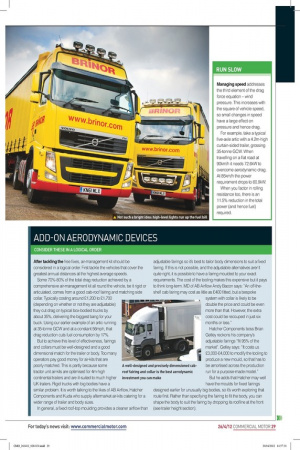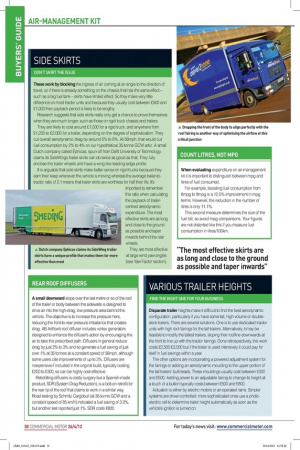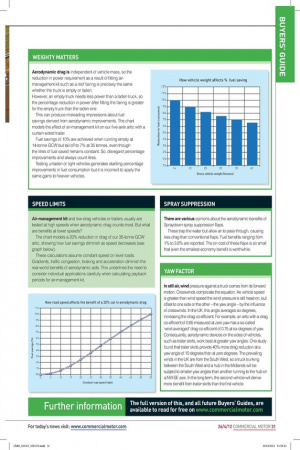THIS WEEK
Page 20

Page 21

Page 22

Page 23

If you've noticed an error in this article please click here to report it so we can fix it.
WE BUY...
Full guide available at www.commercialmotor.com
Nobody disputes that aerodynamics is good science. The task facing operators is how to evaluate the benefit of air-management kit and apply it most effectively to gain maximum return on investment
Aerodynamic drag is the product of a vehicle’s drag co-efficient, its frontal area and wind pressure. Air-management kits address the first of these – drag co-efficient – but to achieve the very lowest drag force you must address the other two elements too, frontal area and wind pressure. This guide considers all three factors, not just drag co-efficient.
The easiest way of saving money is not to spend it in the first place. So, before splashing out on air-management kit, it pays to address the basics most of which cost little or nothing, especially if they are considered when specifying the vehicle.
RUN SMART
Adjustable cab-roof fairings are meant to be adjusted, and failure to do so costs money. Setting a typical tractor unit’s fairing just 200mm (8 inches) lower than the trailer increases overall drag by 6% compared with what could be achieved with a perfect height match. At a gross weight of 35 tonnes and 56mph, this extra drag increases fuel consumption by 3%. This supports the hypothesis that pays to get this critical aero feature exactly right.
RUN CLEAN
Spotlights above the windscreen are expensive and continue to run up a bill with every kilometre covered. They break up the airflow just where you want it attached to the cab’s fairing, flowing tidily across to the trailer or vehicle body. Each light on a truck with a roof-fairing increases fuel consumption by 0.1%, according to vehicle engineering and testing organisation Mira. Roof-mounted air-horns have a similar effect. When specifying box bodies, ensure edges and corners have radiused cappings rather than right-angle joints – sharp edges are bad news for air flow.
RUN CLOSE
The gap between a tractor unit and trailer creates a negative pressure on the cab’s bulkhead, sucking it backwards. The gap also allows air to strike the trailer’s bulkhead, so it acts as a secondary frontal area. Until we can bleed air into the gap to form a high-pressure cushion that solves both these issues, the best we can do is minimise the coupling gap by ensuring that sliding fifth-wheels are set in their optimum position rather than left at their rearmost setting. The same logic applies when mounting a body on rigid chassis; get it as close as possible to the cab.
RUN LOW
Minimising height by using a lower body or trailer reduces the frontal area and thus total drag.
For example, running a trailer with a height of 4.4m instead of 4.5m reduces the frontal area (and hence aerodynamic drag) by 2.2%.
Therefore, when you factor in both aerodynamic drag and rolling resistance, at a 35-tonne GCW and going at a constant speed of 56mph, this reduction in drag cuts the total power requirement – and hence fuel consumption – by a total of 1%.
RUN SLOW
Managing speed addresses the third element of the drag force equation – wind pressure. This increases with the square of vehicle speed, so small changes in speed have a large effect on pressure and hence drag.
For example, take a typical five-axle artic with a 4.2m-high curtain-sided trailer, grossing 35-tonne GCW. When travelling on a flat road at 90km/h it needs 72.6kW to overcome aerodynamic drag. At 85km/h the power requirement drops to 60.9kW.
When you factor in rolling resistance too, there is an 11.5% reduction in the total power (and hence fuel) required.
ADD-ON AERODYNAMIC DEVICES
CONSIDER THESE IN A LOGICAL ORDER After tackling the free fixes, air-management kit should be considered in a logical order. First tackle the vehicles that cover the greatest annual distances at the highest average speeds.
Some 70%-80% of the total drag reduction achieved by a comprehensive air-management kit all round the vehicle, be it rigid or articulated, comes from a good cab-roof fairing and matching side collar. Typically costing around £1,200 to £1,700 (depending on whether or not they are adjustable) they cut drag on typical box-bodied trucks by about 35%, delivering the biggest bang for your buck. Using our earlier example of an artic running at 35-tonne GCW and at a constant 56mph, that drag reduction cuts fuel consumption by 17%.
But to achieve this level of effectiveness, fairings and collars must be well-designed and a good dimensional match for the trailer or body. Too many operators pay good money for air-kits that are poorly matched. This is partly because some tractor unit air-kits are optimised for 4m-high continental trailers and are ill-suited to much higher UK trailers. Rigid trucks with big bodies have a similar problem. It is worth talking to the likes of AB Airflow, Hatcher Components and Kuda who supply aftermarket air-kits catering for a wider range of trailer and body sizes.
In general, a fixed roof-top moulding provides a cleaner airflow than adjustable fairings so it’s best to tailor body dimensions to suit a fixed fairing. If this is not possible, and the adjustable alternatives aren’t quite right, it is possible to have a fairing moulded to your exact requirements. The cost of the tooling makes this expensive but it pays to think long-term. MD of AB Airflow Andy Bacon says: “An off-theshelf cab fairing may cost as little as £400 fitted, but a bespoke system with collar is likely to be double the price and could be even more than that. However, the extra cost could be recouped in just six months or less.” Hatcher Components boss Brian Getley reckons his company’s adjustable fairings “fit 95% of the market”. Getley says: “It costs us £3,000-£4,000 to modify the tooling to produce a new mould, so that has to be amortised across the production run for a purpose-made model.” But he adds that Hatcher may well have the moulds for fixed fairings designed earlier for unusually big bodies, so it’s worth exploring that route first. Rather than specifying the fairing to fit the body, you can shape the body to suit the fairing by dropping its roofline at the front (see trailer height section).
SIDE SKIRTS
DON’T SKIRT THE ISSUE These work by blocking the ingress of air coming at an angle to the direction of travel, so if there is already something on the chassis that has the same effect – such as a big fuel tank – skirts have limited effect. So they make very little difference on most tractor units and because they usually cost between £500 and £1,000 their payback period is likely to be lengthy.
Research suggests that side skirts really only get a chance to prove themselves when they are much longer, such as those on rigid truck chassis and trailers.
They are likely to cost around £1,000 for a rigid truck, and anywhere from £1,200 to £2,000 for a trailer, depending on the degree of sophistication. They cut overall aerodynamic drag by around 5% to 8%. At 56mph, that would cut fuel consumption by 2% to 4% on our hypothetical 35-tonne GCW artic. A small Dutch company called Ephicas, spun-off from Delft University of Technology, claims its SideWings trailer skirts can do twice as good as that. They fully enclose the trailer wheels and have a wing-like leading-edge profile.
It is arguable that side skirts make better sense on rigid trucks because they earn their keep whenever the vehicle is moving whereas the average trailer-totractor ratio of 2:1 means that trailer skirts are worthless for half their life. It’s important to remember this ratio when calculating the payback of trailercentred aerodynamic expenditure. The most effective skirts are as long and close to the ground as possible and taper inwards behind the rear wheels.
They are most effective at large wind yaw angles (see Yaw Factor section).
COUNT LITRES, NOT MPG
When evaluating expenditure on air-management kit it is important to distinguish between mpg and litres of fuel consumed.
For example, boosting fuel consumption from 8mpg to 9mpg is a 12.5% improvement in mpg terms. However, the reduction in the number of litres is only 11.1%.
This second measure determines the size of the fuel bill, so avoid mpg comparisons. Your figures are not distorted like this if you measure fuel consumption in litres/100km.
REAR ROOF DIFFUSERS
A small downward slope over the last metre or so of the roof of the trailer or body between the sidewalls is designed to drive air into the high-drag, low-pressure area behind the vehicle. The objective is to increase the pressure here, reducing the front-to-rear pressure imbalance that creates drag. AB Airflow’s roof diffuser includes vortex generators designed to enhance the diffuser’s action by encouraging the air to take the prescribed path. Diffusers in general reduce drag by just 2% to 3% and so generate a fuel saving of just over 1% at 35 tonnes at a constant speed of 56mph, although some users cite improvements of up to 3%. Diffusers are inexpensive if included in the original build, typically costing £200 to £300, so can be highly cost-effective.
Retrofitting diffusers is costly surgery but a Spanish-made product, SDR (System Drag Reduction), is a bolt-on retrofit for the rear lip of the roof that claims to work in a similar way. Road testing by Schmitz Cargobull (at 38-tonne GCW and a constant speed of 85 km/h) indicated a fuel saving of 3.3%, but another test reported just 1%. SDR costs €800.
VARIOUS TRAILER HEIGHTS
FIND THE RIGHT ONE FOR YOUR BUSINESS Disparate trailer heights make it difficult to find the best aerodynamic configuration, particularly if you have some tall, high-volume or doubledeck trailers. There are several solutions. One is to use dedicated tractor units with high roof-fairings for the tall trailers. Alternatively, it may be feasible to modify the tallest trailers, sloping their roofline downwards at the front to line up with the tractor fairings. Done retrospectively, this work costs £2,500-£3,000 but if the trailer is used intensively it could pay for itself in fuel savings within a year.
The other options are incorporating a powered adjustment system for the fairings or adding an aerodynamic moulding to the upper portion of the tall trailers’ bulkheads. These mouldings usually cost between £300 and £500. Adding power to an adjustable fairing to change its height at a touch of a button typically costs between £500 and £800.
Actuation is either by electric motors or air-operated rams. Simpler systems are driver-controlled: more sophisticated ones use a photoelectric cell to determine trailer height automatically as soon as the vehicle’s ignition is turned on.
WEIGHTY MATTERS
Aerodynamic drag is independent of vehicle mass, so the reduction in power requirement as a result of fitting airmanagement kit such as a roof fairing is precisely the same whether the truck is empty or laden.
However, an empty truck needs less power than a laden truck, so the percentage reduction in power after fitting the fairing is greater for the empty truck than the laden one.
This can produce misleading impressions about fuel savings derived from aerodynamic improvements. The chart models the effect of air-management kit on our five-axle artic with a curtain-sided trailer.
Fuel savings of 10% are achieved when running empty at 14-tonne GCW but tail off to 7% at 35 tonnes, even though the litres of fuel saved remains constant. So, disregard percentage improvements and always count litres.
Testing unladen or light vehicles generates startling percentage improvements in fuel consumption but it is incorrect to apply the same gains to heavier vehicles.
SPEED LIMITS
Air-management kit and low-drag vehicles or trailers usually are tested at high speeds when aerodynamic drag counts most. But what are benefits at lower speeds?
The chart models a 20% reduction in drag of our 35-tonne GCW artic, showing how fuel savings diminish as speed decreases (see graph below).
These calculations assume constant speed on level roads. Gradients, traffic congestion, braking and acceleration diminish the real-world benefits of aerodynamic aids. This underlines the need to consider individual applications carefully when calculating payback periods for air-management kit.
SPRAY SUPPRESSION
There are various opinions about the aerodynamic benefits of Spraydown spray suppression flaps.
These trap the water but allow air to pass through, causing less drag than conventional flaps. Fuel benefits ranging from 1% to 3.8% are reported. The on-cost of these flaps is so small that even the smallest economy benefit is worthwhile.
YAW FACTOR
In still air, wind pressure against a truck comes from its forward motion. Crosswinds complicate the equation. As vehicle speed is greater than wind speed the wind pressure is still head-on, but offset to one side or the other – the yaw angle – by the influence of crosswinds. In the UK, this angle averages six degrees, increasing the drag co-efficient. For example, an artic with a drag co-efficient of 0.65 measured at zero yaw has a so-called ‘wind-averaged’ drag co-efficient of 0.75 at six degrees of yaw. Consequently, aerodynamic devices on the sides of vehicles, such as trailer skirts, work best at greater yaw angles. One study found that trailer skirts provide 40% more drag reduction at a yaw angle of 10 degrees than at zero degrees. The prevailing winds in the UK are from the South West, so a truck trunking between the South West and a hub in the Midlands will be subject to smaller yaw angles than another running to the hub on a NW-SE axis. In the long term, the second vehicle will derive more benefit from trailer skirts than the first vehicle.











































